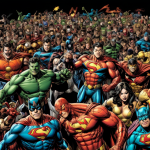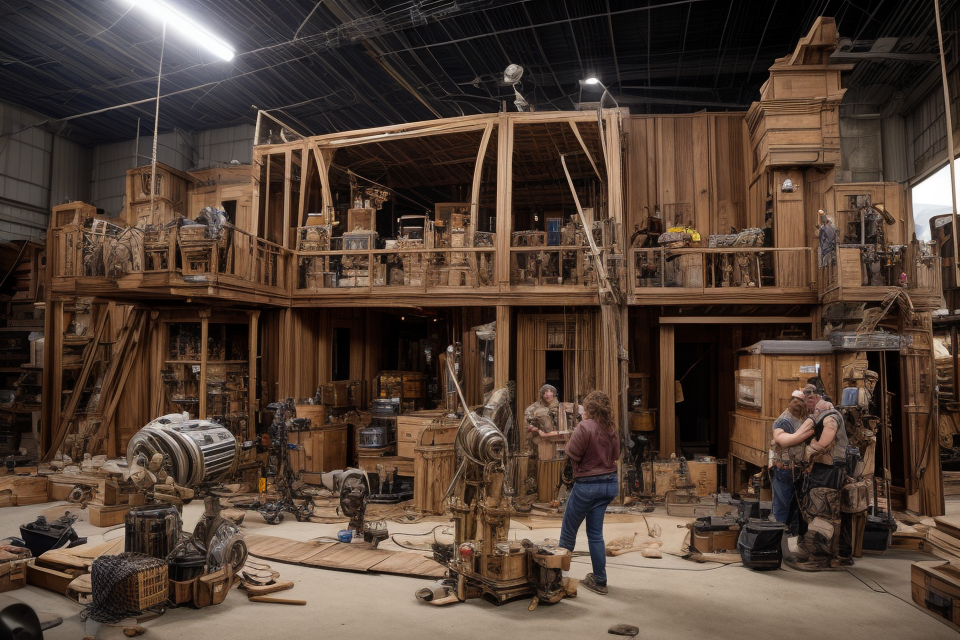The world of Hollywood movies is filled with magical moments and awe-inspiring visuals that leave us spellbound. But have you ever wondered who creates those amazing props that bring those fantastical worlds to life? From intricate costumes to lifelike robots, the props in movies are the unsung heroes of the silver screen. In this article, we’ll delve into the fascinating world of prop creation and discover the talented artists and craftsmen who bring our favorite movies to life. Get ready to uncover the secrets behind the magic of Hollywood props!
The props used in Hollywood movies are typically created by a team of prop makers, artisans, and craftspeople. These professionals work closely with the director, production designer, and other key members of the film crew to create the desired look and feel of the movie. Props can range from small items like guns and jewelry to large and complex set pieces like cars and buildings. The props team is responsible for researching and creating or sourcing the necessary items, as well as ensuring that they are safe and functional for use on set. They also work to maintain continuity and realism within the movie’s world, ensuring that the props are consistent with the time period and location in which the story takes place. Overall, the props team plays a crucial role in bringing the director’s vision to life on screen.
The Importance of Props in Film Production
How Props Enhance the Storytelling Experience
Props play a crucial role in film production, as they help to create a more immersive and realistic experience for the audience. Here are some ways in which props can enhance the storytelling experience:
- Setting the scene: Props can help to set the scene and create a specific atmosphere for a movie. For example, a vintage car can be used to transport the audience back to the 1950s, while a futuristic gadget can help to create a sense of what life might be like in the future.
- Adding depth to characters: Props can also be used to add depth to characters and provide insight into their personalities. For example, a character’s choice of clothing or accessories can reveal their social status, while the contents of their home can provide clues about their interests and hobbies.
- Supporting the plot: Props can also be used to support the plot and move the story forward. For example, a key piece of evidence can be hidden in a prop, or a character may use a prop to solve a problem or overcome an obstacle.
- Creating emotional connections: Props can also be used to create emotional connections between the audience and the characters. For example, a child’s toy can be used to evoke feelings of nostalgia or sadness, while a wedding ring can symbolize the enduring love between two characters.
Overall, props play a vital role in enhancing the storytelling experience in Hollywood movies. They help to create a more immersive and realistic world for the audience, while also providing insight into the characters and supporting the plot.
The Role of Props in Creating Immersive Environments
Props play a crucial role in creating immersive environments in film production. They are the physical objects that actors interact with and that help to convey the story. Props can be anything from a simple item like a pen or a cup to a complex piece of machinery or a full-scale set. The use of props is not limited to the film industry; they are also used in television shows, theater productions, and even in commercials.
One of the primary functions of props is to create a sense of realism in the scene. When actors interact with real objects, it makes the scene feel more authentic and believable. For example, in a hospital scene, the use of real medical equipment and supplies can add to the believability of the scene. In addition, props can also be used to establish the time period and location of the scene. A vintage car or a period-correct costume can help to transport the audience to a different time and place.
Props can also be used to enhance the storytelling and the overall tone of the film. For example, in a horror movie, the use of creepy-looking props like dolls or old taxidermy animals can create a sense of unease and tension. In a romantic comedy, the use of cute and quirky props like a collection of vintage tea cups or a quirky lamp can add to the lightheartedness of the scene.
Another important role of props is to help actors perform their roles more effectively. Props can be used to help actors create a character’s backstory or to convey emotions. For example, in a drama, a prop like a worn-out teddy bear can help to convey the character’s sadness and loss. In addition, props can also be used to help actors remember their lines or to help them with their blocking.
Overall, the use of props is essential in creating immersive environments in film production. They help to create a sense of realism, enhance the storytelling, and aid actors in their performances.
The Psychology Behind Props and Their Impact on the Audience
Pro
The Prop Making Process
Designing and Conceptualizing Props
The process of creating props for Hollywood movies begins with the design and conceptualization phase. This stage involves a team of artists, designers, and prop makers working together to create detailed drawings, sketches, and models of the props that will be used in the film.
The first step in the design process is to carefully study the script and understand the storyline, characters, and settings. The prop designers then create sketches and drawings of the props that will be needed, taking into account the time period, location, and overall aesthetic of the film.
Once the designs are finalized, the prop makers begin constructing the props using a variety of materials, including wood, metal, plastic, and fabric. They may also use found objects or antiques to create unique and authentic props.
During the conceptualization phase, the prop makers also consider the function of the props and how they will be used in the film. For example, a prop gun must be designed to look and feel realistic, but it must also be safe to use on set and easy to handle for the actors.
Overall, the design and conceptualization phase is a crucial part of the prop making process, as it sets the tone for the entire film and helps to bring the story to life on screen.
The Art of Prototype Development
Developing a prototype is a crucial step in the prop-making process for Hollywood movies. It involves creating a model or sample of a prop that will be used as a reference for the final product. The prototype serves as a guide for the rest of the production team, helping them visualize the final product and make any necessary adjustments before the prop is mass-produced.
The prototype development process typically begins with the conceptual design phase, where the prop designer creates sketches and drawings of the prop. These sketches are then refined and turned into a three-dimensional model, which is used to create the prototype.
Creating a prototype requires a high level of skill and expertise. Prop makers must have a deep understanding of materials and construction techniques, as well as an eye for detail and accuracy. They must also be able to work within tight deadlines and budgets, often under intense pressure.
Once the prototype is complete, it is reviewed by the production team to ensure that it meets the required specifications. Any necessary adjustments are made, and the prototype is then used as a guide for the production of the final prop.
In some cases, the prototype may be used in the film itself, particularly if it is a complex or unique prop that requires special attention. In these cases, the prop maker must ensure that the prototype is of the highest quality and can withstand the demands of film production.
Overall, the art of prototype development is a crucial aspect of the prop-making process for Hollywood movies. It allows the production team to visualize the final product and make any necessary adjustments before the prop is mass-produced, ensuring that the final product is of the highest quality and accuracy.
Material Selection and Construction Techniques
In the world of Hollywood movie production, the props used in films play a crucial role in bringing the story to life. From the most intricate pieces to the grandest sets, each prop must be carefully crafted to create an immersive experience for the audience. In this section, we will delve into the material selection and construction techniques used by prop makers to create the props used in Hollywood movies.
Material Selection
When it comes to creating props for Hollywood movies, the material selection process is crucial. The material chosen must not only be visually appealing but also durable enough to withstand the demands of film production. Common materials used in prop making include:
- Wood
- Metal
- Plastic
- Resin
- Fabric
- Paper
- Glass
Each material has its own set of advantages and disadvantages, and the prop maker must choose the right material for the job based on the requirements of the prop and the scene it will be used in. For example, a prop gun would require a material that is both lightweight and durable, while a prop piece of furniture would need to be sturdy enough to withstand the rigors of filming.
Construction Techniques
Once the material has been selected, the prop maker must then decide on the construction techniques to be used. The construction techniques chosen will depend on the complexity of the prop and the desired end result. Some common construction techniques used in prop making include:
- Assembly: This technique involves combining different parts to create a single prop. For example, a prop gun may be made by combining a metal or plastic body with various metal or plastic parts.
- Casting: This technique involves pouring liquid material into a mold to create a desired shape. This technique is often used to create props that require a specific shape or texture.
- Painting and Finishing: Once the prop has been constructed, it must be painted and finished to give it a realistic look. This may involve painting the prop to match a specific color scheme or adding weathering and wear and tear to make it look more authentic.
In conclusion, the material selection and construction techniques used in prop making for Hollywood movies are crucial to creating realistic and immersive props that bring the story to life. From the material selection process to the construction techniques used, each prop must be carefully crafted to meet the demands of film production and provide an engaging experience for the audience.
The Influence of Budget and Time Constraints on Prop Making
The Significance of Budget Allocation
Budget allocation plays a crucial role in prop making for Hollywood movies. The allotted budget directly impacts the quantity and quality of props that can be created. Consequently, the creative team must carefully consider which props are essential to the storyline and can justify the investment. This often leads to prioritizing props that are prominently featured or have a significant emotional or plot-driven value.
The Impact of Time Constraints
Time constraints are another significant factor influencing prop making in Hollywood movies. The production schedule is tight, and the prop-making process must be efficiently managed to meet deadlines. Rushed prop creation can lead to subpar results, which may affect the overall quality of the film. Thus, the prop-making team must work closely with the director and production team to determine realistic timelines for prop completion, ensuring that the creative vision is realized within the constraints of the schedule.
Balancing Budget and Time Constraints
Balancing budget and time constraints is a delicate process that requires careful consideration and coordination. The prop-making team must be resourceful and innovative in their approach, finding cost-effective solutions that meet the creative requirements. This may involve repurposing existing props, creating props in-house, or collaborating with external prop vendors to source affordable options. Time management is also crucial, with the prop-making team working efficiently to maximize productivity while maintaining the quality of their work.
In conclusion, the influence of budget and time constraints on prop making for Hollywood movies is significant. The prop-making team must navigate these challenges skillfully, balancing creative vision with practical limitations, to produce high-quality props that enhance the overall cinematic experience.
The Roles of Prop Makers in Film Production
The Collaborative Nature of Prop Making
Prop making is a highly collaborative process in film production. It involves a team of skilled professionals working together to create props that enhance the storytelling and bring the scenes to life. Here are some key aspects of the collaborative nature of prop making:
- Design and Development: The prop maker collaborates with the production designer and director to develop a concept for the prop. The prop maker creates sketches, models, and prototypes to refine the design and ensure it meets the requirements of the story.
- Material Selection: The prop maker works with the director and production designer to select the appropriate materials for the prop. This involves considering factors such as durability, cost, and authenticity.
- Construction and Fabrication: The prop maker oversees the construction and fabrication of the prop. This involves working with a team of carpenters, metalworkers, and other skilled craftsmen to build the prop according to the design specifications.
- Painting and Finishing: The prop maker works with the painting and finishing team to ensure that the prop is painted and finished to match the requirements of the story. This may involve creating special effects, aging the prop, or adding weathering and wear and tear.
- Integration with Sets and Costumes: The prop maker collaborates with the set decorator and costume designer to ensure that the prop integrates seamlessly with the sets and costumes. This involves considering factors such as color, texture, and style to create a cohesive visual aesthetic.
Overall, the collaborative nature of prop making is essential to the success of a film. The prop maker must work closely with a wide range of professionals to ensure that the props are not only functional but also visually stunning and effective in enhancing the storytelling.
The Interplay between Prop Makers and Directors
In the fast-paced world of film production, the interplay between prop makers and directors is a crucial element that can make or break a movie’s success. Prop makers are responsible for creating or sourcing the physical objects that actors interact with on set, ranging from weapons and costumes to furniture and vehicles. Meanwhile, directors oversee the entire production process, working closely with prop makers to ensure that the props they need are made or obtained in a timely and efficient manner.
The relationship between prop makers and directors is a complex one, with both parties relying on each other to make the movie come together. Prop makers must understand the director’s vision and be able to translate it into physical objects that fit seamlessly into the narrative. Meanwhile, directors must communicate their needs clearly to prop makers, who may have limited time and resources to work with.
To ensure that the props meet the director’s requirements, prop makers must work closely with the production design team. This team is responsible for creating the overall look and feel of the movie, including the sets, costumes, and props. Prop makers must collaborate with production designers to ensure that the props they create or source fit seamlessly into the production design, while also meeting the needs of the director.
Despite the challenges, the interplay between prop makers and directors can lead to some of the most iconic moments in film history. From the legendary light sabers of Star Wars to the iconic clock from Pulp Fiction, the props created by prop makers often become just as memorable as the actors themselves. As such, the relationship between prop makers and directors is a crucial one that requires a high level of communication, creativity, and collaboration to produce the best possible results.
The Vital Contributions of Prop Makers to Cinematic Success
The role of prop makers in film production is often overlooked, but their contributions are vital to the success of a movie. Prop makers are responsible for creating and providing the objects and items that appear on screen, and their work plays a crucial role in setting the tone and atmosphere of a film.
Here are some of the ways in which prop makers contribute to cinematic success:
- Creating realism: One of the primary functions of prop makers is to create objects that look and feel realistic on screen. This is especially important in genres like drama and period pieces, where the audience needs to believe that the objects and environments are authentic to the time and place in which the story is set. Prop makers work closely with directors, producers, and costume designers to ensure that the props they create fit seamlessly into the overall aesthetic of the film.
- Enhancing storytelling: In addition to creating realistic props, prop makers also play a key role in enhancing the storytelling of a film. They work with directors and writers to come up with creative ways to use props to convey meaning and emotion. For example, a prop might be used to symbolize a character’s inner turmoil or to foreshadow an upcoming event.
- Supporting actors: Prop makers also work closely with actors to ensure that the props they use are appropriate for their characters and the scene. They may provide guidance on how to handle props, how to use them effectively, and how to incorporate them into an actor’s performance.
- Saving time and money: Finally, prop makers are often responsible for finding creative solutions to save time and money on set. They may repurpose existing objects or create props that can be used in multiple scenes, which can help to streamline production and keep costs under control.
Overall, the work of prop makers is essential to the success of a film. Their ability to create realistic and effective props helps to transport audiences to different worlds and enhance the storytelling of a movie.
Famous Prop Makers and Their Works
The Career of Oscar-Winning Prop Master, Tim Webber
Tim Webber is an Academy Award-winning prop master who has been working in the film industry for over three decades. He has worked on some of the most iconic movies of all time, including “Gladiator,” “The Dark Knight,” and “Inception.”
Webber began his career in the film industry as a model maker, working on films such as “Lara Croft: Tomb Raider” and “The Fifth Element.” He then transitioned into prop making, working on films such as “The Phantom of the Opera” and “Munich.”
One of Webber’s most notable projects was his work on the Christopher Nolan film “Inception.” He was responsible for creating the iconic “totem” that played a central role in the film’s plot. The totem was a prop that could be used to determine whether someone was in a dream or in reality, and it was a crucial element of the film’s story.
Webber’s work on “Inception” earned him an Academy Award for Best Achievement in Visual Effects, which he shared with the film’s other prop masters and special effects artists. He has also been nominated for several other awards for his work on films such as “Gladiator” and “The Dark Knight.”
In addition to his work on films, Webber has also worked on several television shows, including “Game of Thrones” and “Doctor Who.” He has also taught prop making at the University of Hertfordshire and has been a guest lecturer at several other universities.
Overall, Tim Webber’s career as a prop master has been marked by his exceptional skill and creativity, as well as his dedication to his craft. He has played a key role in bringing some of the most iconic props and set pieces in film history to life, and his work has been recognized with several prestigious awards.
The Visual Effects Wizard Behind the Harry Potter Series, Nick Dudman
Nick Dudman is a renowned visual effects artist and prop maker who has worked on numerous films and television shows, including the Harry Potter series. He began his career in the film industry in the 1970s, working as a special effects assistant on films such as “The Spy Who Loved Me” and “Superman.”
In the early 1990s, Dudman was approached by the production team of the first Harry Potter film to create a range of magical props and creatures. He went on to work on all eight films in the series, creating some of the most iconic props in the franchise, such as the Marauder’s Map, the Sorting Hat, and the Deathly Hallows.
Dudman’s work on the Harry Potter series was praised for its attention to detail and creativity. He was known for his ability to bring J.K. Rowling’s magical world to life on screen through his props and creatures. His contributions to the series were critical to its success and helped to establish the visual language of the wizarding world.
In addition to his work on the Harry Potter series, Dudman has also worked on other high-profile films such as “GoldenEye,” “The Fifth Element,” and “Alien 3.” He has received numerous awards for his work in the film industry, including a BAFTA for his contributions to the Harry Potter series.
Dudman’s legacy as a prop maker and visual effects artist is secure, and his contributions to the film industry have inspired a new generation of artists and filmmakers. His work on the Harry Potter series will continue to be celebrated for years to come.
The Innovative Prop Designs of Star Wars Creator, Ralph McQuarrie
Ralph McQuarrie, the legendary concept artist and prop designer, played a pivotal role in the visual development of the Star Wars franchise. He collaborated closely with George Lucas, the director, to create some of the most iconic and innovative prop designs in the history of cinema.
In 1975, Lucas hired McQuarrie to work on the original Star Wars film. McQuarrie’s contributions to the project were instrumental in shaping the visual language of the film. He was responsible for designing the look of the Star Wars universe, including spaceships, characters, and props. His concept art for the Millennium Falcon, the spaceship piloted by Han Solo, became the basis for the final design of the ship used in the film.
McQuarrie’s prop designs were not only visually stunning but also functional. He was a master of combining art and engineering to create props that were both aesthetically pleasing and technically feasible. His attention to detail was unparalleled, and he was known for his ability to envision props that were ahead of their time.
One of McQuarrie’s most iconic prop designs was the light saber used by Luke Skywalker in the original Star Wars film. He created several different versions of the weapon, each with unique features and characteristics. The final design of the light saber, with its iconic blue and red energy blades, became one of the most recognizable props in movie history.
McQuarrie’s influence on the Star Wars franchise extended beyond the original film. He worked on the sequels, The Empire Strikes Back and Return of the Jedi, as well as the prequels, Episode I, II, and III. His prop designs for the franchise continue to inspire new generations of filmmakers and fans alike.
In conclusion, Ralph McQuarrie’s innovative prop designs played a crucial role in the success of the Star Wars franchise. His ability to combine art and engineering to create functional and visually stunning props continues to inspire prop makers in Hollywood today.
The Future of Prop Making in Film
The Impact of Technological Advancements on Prop Making
As technology continues to advance, the film industry is constantly evolving, and prop making is no exception. With the help of modern technology, prop makers can now create more realistic and complex props than ever before. Here are some of the ways in which technological advancements are impacting prop making in film:
Computer-Aided Design (CAD)
One of the most significant advancements in prop making is the use of computer-aided design (CAD) software. This technology allows prop makers to create highly detailed and accurate designs, which can then be used to create physical props. CAD software also allows prop makers to make changes and adjustments quickly and easily, saving time and money in the production process.
3D Printing
Another technological advancement that has had a significant impact on prop making is 3D printing. This technology allows prop makers to create highly detailed and complex props quickly and at a lower cost than traditional methods. 3D printing also allows for the creation of props that would be impossible to create using traditional methods, such as props with intricate internal mechanisms.
Virtual Reality (VR)
Virtual reality (VR) technology is also being used in prop making to create highly realistic props. VR technology allows prop makers to create digital models of props and then test them in a virtual environment before creating the physical prop. This technology is particularly useful for creating props that need to be interactive, such as futuristic gadgets or weapons.
Augmented Reality (AR)
Augmented reality (AR) technology is also being used in prop making to create more realistic and immersive experiences for film audiences. AR technology allows prop makers to add digital elements to physical props, such as holographic displays or interactive touchscreens. This technology is particularly useful for creating props that need to be integrated into a digital world, such as futuristic vehicles or computer interfaces.
In conclusion, technological advancements are having a significant impact on prop making in film. With the help of CAD, 3D printing, VR, and AR technology, prop makers can now create more realistic and complex props than ever before. These technologies are not only saving time and money in the production process but are also enabling filmmakers to create more immersive and engaging experiences for their audiences.
The Role of Virtual Reality and 3D Printing in Modern Prop Design
In the modern era of filmmaking, the use of virtual reality (VR) and 3D printing technologies have revolutionized the process of creating props for Hollywood movies. These technologies have enabled prop makers to create more realistic and complex props with greater ease and efficiency than ever before.
3D printing technology has become an essential tool for prop makers in the film industry. It allows them to create intricate and detailed props quickly and cost-effectively. With 3D printing, prop makers can create a wide range of objects, from small props like weapons and gadgets to large-scale set pieces like vehicles and buildings. The technology also enables prop makers to create props with a high level of detail and precision, making them look more realistic and believable on screen.
One of the biggest advantages of 3D printing is its ability to create complex shapes and geometries that would be difficult or impossible to create using traditional methods. For example, prop makers can use 3D printing to create props with intricate mechanical components, such as gears and springs, that would be difficult to create by hand. Additionally, 3D printing allows prop makers to create props with a high level of customization, making it easier to create unique and one-of-a-kind props for specific scenes or characters.
Virtual Reality
Virtual reality (VR) technology has also played a significant role in modern prop design for Hollywood movies. VR allows prop makers to create virtual models of props and sets, which can be manipulated and tested in a virtual environment before they are built in real life. This technology has become especially useful for creating complex and detailed set pieces, such as futuristic cities or alien landscapes.
One of the biggest advantages of VR in prop design is its ability to save time and money. By creating virtual models of props and sets, prop makers can test and refine their designs before they are built, reducing the need for costly revisions and rebuilds. Additionally, VR allows prop makers to collaborate more effectively with other members of the film crew, such as directors and cinematographers, by providing a shared virtual environment where they can discuss and plan the visual elements of a scene.
In conclusion, the use of virtual reality and 3D printing technologies has revolutionized the process of creating props for Hollywood movies. These technologies have enabled prop makers to create more realistic and complex props with greater ease and efficiency than ever before, saving time and money while enhancing the overall quality of the final product. As these technologies continue to evolve and improve, it is likely that they will play an even more important role in the future of prop making in film.
The Continuing Evolution of Prop Making in the Film Industry
As technology continues to advance, the art of prop making in the film industry is also evolving. With the increasing use of digital technology, props are becoming more sophisticated and realistic. Here are some ways in which prop making is evolving in the film industry:
- Digital Props: One of the most significant changes in prop making is the use of digital technology. Digital props are computer-generated objects that can be used in place of physical props. These props can be manipulated in real-time and can be made to look incredibly realistic. Digital props are also easier to store and transport than physical props, making them a more practical option for filmmakers.
- 3D Printing: Another advancement in prop making is the use of 3D printing. This technology allows prop makers to create highly detailed and intricate objects that would be difficult or impossible to create using traditional methods. 3D printing also allows for greater flexibility in terms of the materials that can be used to create props. For example, prop makers can now create props using metals, ceramics, and other materials that were previously difficult to work with.
- Virtual Reality: Virtual reality (VR) technology is also being used in the film industry to create more immersive experiences for audiences. Prop makers can use VR to create virtual props that can be interacted with in real-time. This technology allows for greater flexibility in terms of the types of props that can be created and used in films.
- Sustainability: In recent years, there has been a growing emphasis on sustainability in the film industry. Prop makers are increasingly using eco-friendly materials and techniques to create props. This includes using recycled materials, creating props that can be reused in multiple productions, and using digital technology to reduce the need for physical props.
Overall, the continuing evolution of prop making in the film industry is driven by a desire to create more realistic and immersive experiences for audiences. As technology continues to advance, it is likely that prop making will continue to evolve and change in exciting new ways.
FAQs
1. Who creates the props for Hollywood movies?
The props for Hollywood movies are created by a team of professionals known as prop masters or prop designers. These individuals are responsible for researching, designing, and creating all the objects and items that appear on screen. They work closely with the director, production designer, and other members of the production team to ensure that the props are accurate, functional, and help to tell the story.
2. What types of props are used in movies?
There are many different types of props used in movies, ranging from small items like guns and jewelry to large sets and vehicles. Props can be anything from everyday objects to fantastical creations, and they are often designed to help create a specific mood or atmosphere. For example, a period drama might require props like antique furniture, costumes, and vintage vehicles, while a science fiction movie might call for futuristic weapons and technology.
3. How are props made for movies?
Props for movies are often made by a combination of craftsmen, artists, and technicians. They may be constructed from scratch using materials like wood, metal, and plastic, or they may be found and modified to fit the needs of the production. For more complex props, such as costumes or animatronics, special effects experts may be brought in to help create them. In addition, many props are rented or sourced from prop houses, which are specialized companies that rent out props to the film industry.
4. What role do props play in movies?
Props play a crucial role in helping to tell the story of a movie. They can help to establish the time period, setting, and characters, and they can also be used to convey important themes and messages. For example, a prop like a gun can symbolize power, danger, or violence, while a prop like a key can represent secrets, access, or control. Props can also help to create a sense of realism and authenticity, which can make the story more engaging and immersive for the audience.









